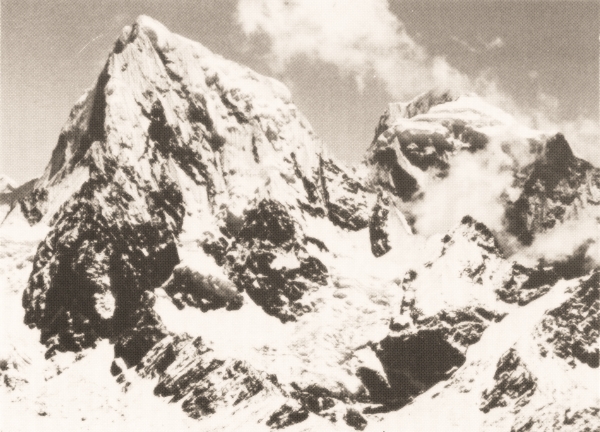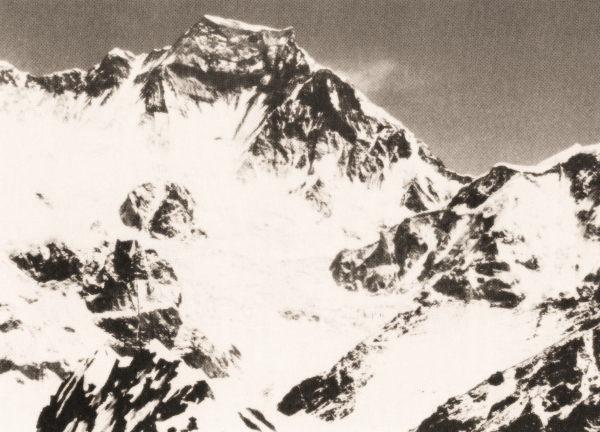Himalayan Trek
by T.A. Kay
Ever since Hillary and Tenzing set foot on the summit of Everest it has been an ambition of mine to travel in the Himalayas and gaze upon the highest mountain on Earth. In 1983 an opportunity arose and I joined a small party to trek about 150 miles in the Everest area.
After a flight over Germany, Poland and Russia, our group of eight, six men and two women, landed in Kathmandu where we stayed for two days before the trek started. We spent this time seeing the sights of the city and the Kathmandu Valley.
The city streets were a jumble of rickshaws, bicycles, ancient vehicles, cows and pigs. People were thronging everywhere, trying to sell prayer wheels of various sizes and designs, and huge kukris with razor-sharp edges.
There had been no flights to the Lukla airstrip for two days, but fortunately the weather cleared when we were due to fly out. A 45 minute flight by Twin Otter took us to Lukla, 9000 feet up in the Himalayas and there we met the Sherpas who were to accompany us on the trek, and also the twenty or thirty porters who carried our camping gear and food for three days until it was put on yaks. An hour after we arrived at Lukla, Reinhold Messner landed in the King of Nepal’s private plane, en route to Cho Oyo, another 8000 metre peak to add to his tally; we met the great man in Namche.
Our first day’s trek was downhill for about 1000 feet, to the Dudh Kosi river. We passed many traders and porters -all the goods are carried on porters backs, regardless of bulk or weight – and we met quite a number of scruffy, though obviously very happy young urchins. We camped at Sarogumaga and there we met a 14 year old boy who attends the “local” Hillary school – four hours walk away – and a very bright lad he was. He spoke English very well, but admitted that his least favourite subject at school was “hygiene”.
It rained most of the night, and this meant, of course, that higher up there would be fresh snow. We awoke at 6.30a.m. and were off by 8.00a.m. We passed through Jorsale two hours later and inspected the Japanese “market garden” which was built to produce vegetables for the “Mount Everest Hotel”, the biggest white elephant in the Himalayas, which closed down years ago. The market garden is still maintained and is like an oasis.
The climb of 2000 feet up to Namche was taken a bit too fast, and as a result I suffered from a severe headache for two days, but this coincided with bad weather and so we stayed in Namche until things improved. To while away the time I roamed the “streets” of Namche and imagine my surprise when I heard a familiar Y.R.C. voice – none other than Roy Pomfret who was also trekking to Everest.
Altitude and three feet of new wet snow made the going hard next day. We slept at Khunde that night in a Sherpa house and next day went on to the monastery at Khumjung. There we were shown the yeti scalp which Hillary took to America some years ago for scientific investigation. The shape of the scalp and the colour of the hairs on it were very much like a bear scalp.
Ama Dablam dominates the valley and we heard that an Austrian team was currently climbing on it – they subsequently succeeded in getting to the top.
We swung into the Gokyo Valley, the snow getting deeper and wetter and for the next three days we gradually gained height and then camped at the base of Cho Oyo. This was our coldest night, and next morning everything was frozen solid – boots, suncream, cameras, tents; the Sherpas suffered badly, some from snow blindness because they refused to wear their snow goggles.
We climbed Gokyo Kang (18000 feet high), a magnificent view point, and spent 2Vi hours on top, viewing and photographing Everest (8 miles away), Changtse (in Tibet), Makalu, Cho Oyo and range upon range of unknown mountains. Best of all was Cholatse across the valley, first climbed the previous year by Bill O’Connor from Harrogate with an American team.
It had been our aim to cross the Chola La pass at about 17500 feet, just north of Cholatse, and then descend to Lobouje, near to the Everest base camp, but it was choked with fresh snow and was totally impassable. We therefore had to retrace our steps down the Gokyo Valley, and it was hardest for our accompanying yaks who had not eaten for four days because the snow covered their grazing grounds. We camped at Pheriche, a desolate, straggling group of houses made of frozen sod and tin. Next day we met two members of the American team that was then climbing Everest – the team doctor who had descended for a rest, but in so doing had got snow blindness, and Dick Bass, a 50 year old who was travelling round the world, systematically climbing the highest summit of every continent.
We then moved on to Lobouje and camped beside the Khumbu glacier, two miles from the Everest ice-fall. The ramparts of Nuptse on the opposite side of the glacier in the afternoon sun were a fine sight. Next day I climbed alone up Kala Pattar, a small summit at about 18000 feet beneath Pumori which gives a superb view into the western cwm of Everest. Visibility was not too good and part of Everest, one mile away, was obscured by mist. Nevertheless, Changtse, over the Lho La in Tibet was clear, as was the Everest ice-fall, and occasionally the boom of falling seracs echoed across the valley.
One mile to the west the map named an area as Changri La, and try as I might I could see nothing particularly magical about it, but surrounded by Everest, Nuptse, Lhotse and Pumori, it would have to be exceptional, to say the least, to merit any particular note.
I waited IVi hours hoping for better visibility and for the others to catch up, but the weather was deteriorating by the minute, and I had to descend.
The remainder of the trek became easier day by day as we gradually descended and inhaled the thick and luscious air at the lower altitudes. Our return route was via Pangboche monastery, where we saw another yeti scalp, and Thyangboche monastery, in an unbelievably beautiful position, surrounded by ice fluted peaks.
The altitude, the cold, the exceptional amount of snow, and the food all combined to make the trek quite tough, but it was nevertheless a superb experience and I would recommend every member of the Club to go to the Himalayas once at least before finally hanging up his boots.

